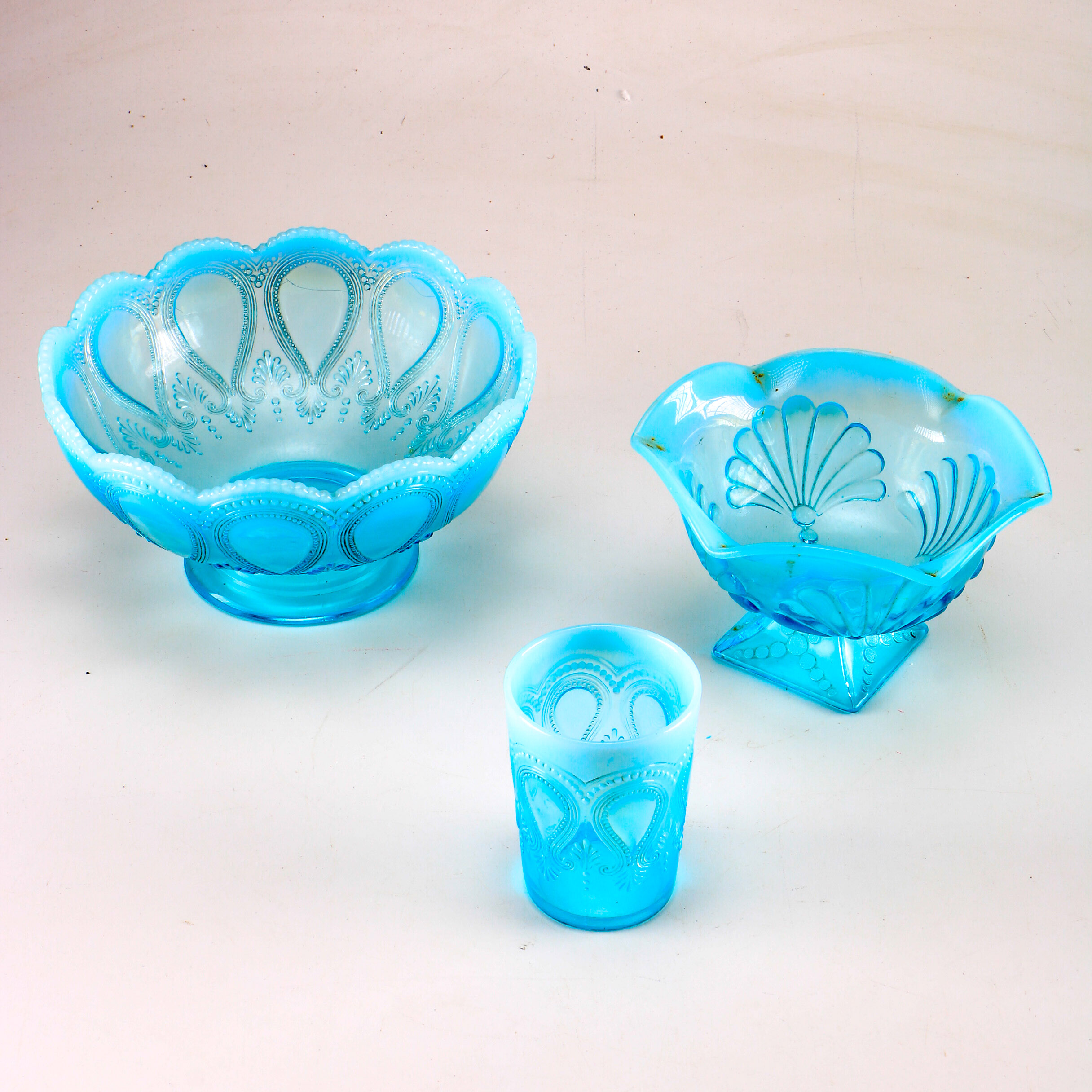
For more information on Carnival Glass, check out this great site: ). Carnival Glass, first produced about 1908, and extremely popular throughout the 1920s, and again in the 1970s, is merely a general term which means glass that has been “carnivalized”, that is, has an iridescent multi-colored “rainbow sheen” or “gasoline on water puddle” appearance, produced by spraying metallic salts on the glass surface during manufacture. (Although so-called “ Carnival Glass” is a separate category, that term is also frequently misunderstood). Some of these pieces were given away at carnivals or fairs, as a prize for throwing a coin accurately if you managed to get it to land inside a piece of glassware, or to win another type of prize at the booth. “Sharon” or “Cabbage Rose” pattern dinner plate in pink glass, made by Federal Glass Company in the 1930s. Some businesses would give away one piece of glassware to each customer just for coming in the door. Small saucers or tumblers might be included inside a box of oatmeal, or given away at a gas station with a gasoline fill-up. Much of this type of glass was given away as premiums, as a marketing ploy to help increase sales of a product or service. Smith Glass Company and Westmoreland Glass Company.įor a webpage that illustrates many of the known patterns of Depression Glass, check out this article on the site.

The most important companies to produce Depression glassware include: Hazel Atlas Glass Company, Hocking Glass Company (and later Anchor Hocking Glass Company/Corporation), Federal Glass Company, Indiana Glass Company, MacBeth-Evans Glass Company, Jeannette Glass Company, Imperial Glass Company, Lancaster Glass Company, U.S. This type of glass is sometimes incorrectly labeled “Vaseline glass”, although true Vaseline glass (also containing uranium) is a separate category, trending to some shade of yellow or canary, and much of that type of glass actually dates from the late Victorian era, having reached a height of popularity in the mid to late 1880s.ĭepression Glass green dish – A reader has stated this is the “Modernistic” pattern by Westmoreland Glass Company, possibly a cheese stand. The great majority of the green Depression-era glass contains very small quantities of uranium, which causes the glass to glow a fluorescent green under an ultraviolet light (blacklight). Colors that were made in lesser quantities, and thus are harder to find, include amethyst, true yellow (canary), cobalt blue, opaque black (may appear intense purple when held to the light), jadeite (an opaque or translucent green), white milk glass, and red.

The most common and popular colors produced were light to medium green, pink, and amber (usually a light yellow-amber or golden amber), along with clear glass (called “crystal” in company catalogs of the time period). Large quantities of true Depression glass was made, by more than 20 different glass companies, and virtually all of these manufacturers were located in the Midwest or Eastern United States. (Much of so-called Depression glass for sale on online auction sites is actually reproduction glass, made in Asia during the last few years, even being imported today! Terms used such as “Depression era-style” or “Depression style” indicate these are new or recent items.)

Note: Some “Depression Glass” patterns have been reproduced in more recent years, notably in the 1970s, but even up to the present day. Basically, this is a catch-all phrase for a general type of inexpensive glassware, in clear or colors, that was sold (or given away as premiums) during the late 1920s into the early 1940s. “Depression glass” is also a term that is sometimes bandied about indiscriminately by glass collectors, sometimes incorrectly. “Depression Glass” might be defined as collectible, mass-produced glassware (principally tableware), inexpensively produced and very popular in average American households beginning in the late 1920s, throughout the 1930s and into the 1940s.


 0 kommentar(er)
0 kommentar(er)
